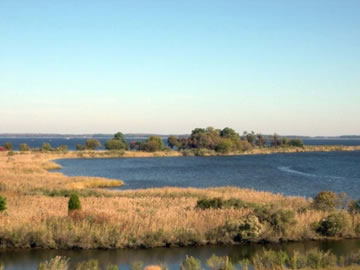
Resource Conservation and Management
Effective planning is vital to achieving sustainability in our living environs. Through concentrating development where supporting infrastructure exists, smart growth uses fewer land resources and has less impact on the environment. In contrast, development outside of established population centers removes more farmland and forests per person, requires septic systems – which pollute groundwater more than sewage treatment plants – and requires costly transportation, schools and other public services.
Sound land use planning considers the environmental effects of wastewater and stormwater runoff on rivers, streams and estuaries, ensures the preservation of farms and forest land, protects communities from environmental impacts, seeks to reduce greenhouse gas emissions, energy use and air pollution, and provide for the minimization and proper handling of solid wastes.
Planning’s resource conservation work supports land preservation and water resource protection and restoration efforts. Planning works with other agencies to prepare for climate change. Staff use analytic tools including land use and land cover data, development capacity analyses and modeling to support environmental protection at the state and local levels.
If you have questions about Resource Conservation and Management, please email
Jason Dubow, Manager, Resource Conservation and Management Unit.

Water Resources Planning
Planning works with counties and municipalities on water resources planning, offering guidance and data and analysis to local governments to ensure that water and sewer plans and comprehensive plan water resource elements efficiently manage water, wastewater and stormwater.
Learn more
Chesapeake Bay
The
Chesapeake Bay Program is a multi-state, regional partnership working to restore the Bay since 1983. Partners include the states of Maryland, Pennsylvania and Virginia, the District of Columbia, the Chesapeake Bay Commission, the Environmental Protection Agency, and citizen advisory groups. Planning is one of Maryland’s participating agencies, providing staff support, policy advocacy, and data and analysis to ensure regional and state policies support smart growth and reflect Planning’s land use, parcel and demographic data and forecasts.
Learn more
Forest Resource Planning
The Forestry Guidance to Local Governments document, completed in 2022, has two main goals. The first is to help make local officials familiar with the many facets of forestry and the Maryland state laws and regulations that govern it. Secondly, the goal is to provide examples of how local planning and zoning can accommodate the different aspects of forestry. The aim is to help local officials become more familiar with forestry practices in their jurisdictions and to streamline the permitting process. The guidance also provides many definitions of forestry-related terms to help local officials better understand the many aspects of forestry. Learn more. Note that this guidance is different from the Technical Study on Changes in Forest Cover and Tree Canopy in Maryland, required by the Tree Solutions Now Act of 2021, and to be completed by the Harry R. Hughes Center for Agro-Ecology, for the purpose of reviewing changes in forest cover and tree canopy in Maryland. See pages 22-24 of the following law.
The Forest Resource Planning webpage provides local jurisdictions with guidelines, recommendations, and technical assistance on policies and standards to protect forests and trees as lands are developed. The webpage also provides local jurisdictions with guidance and assistance with green infrastructure and urban tree canopy planning. Learn more
To protect forests and trees, planners undertake three major steps: designate areas to protect; decide how to purchase or limit development rights in designated areas; and decide how to best preserve trees during the development process. The Forest Resource Planning webpage is organized by each of these three major steps to facilitate local research, analysis, and decision-making for local forest and tree protection plans and policies. This also includes a section on urban tree canopy planning, given strong interest among many Maryland jurisdictions.
Climate Change Mitigation and Adaptation
Climate change will affect Maryland in a variety of ways, from increased risk for extreme events such as drought, storms and flooding, saltwater intrusion and salinization associated with these events and from sea-level rise, to increased erosion and inundation of low-lying areas along the state’s shoreline and coast. Even as the state moves forward to reduce greenhouse gases, climate impacts will be felt. Therefore, adaptation strategies, together with mitigation, are necessary to address climate change.
Learn more
Land Preservation
One of Maryland’s most significant land preservation programs, Program Open Space, was enacted into law in 1969. Since then, the Maryland Agricultural Land Preservation Foundation, Rural Legacy, Maryland Environmental Trust and
Transfer of Development Rights Programs have helped protect agricultural and resource lands. Learn more
Solid Waste Management
Solid waste management impacts every aspect of daily life and public infrastructure. From collections to processing the waste, every community and locale is impacted by these operations – public and private.
Learn more